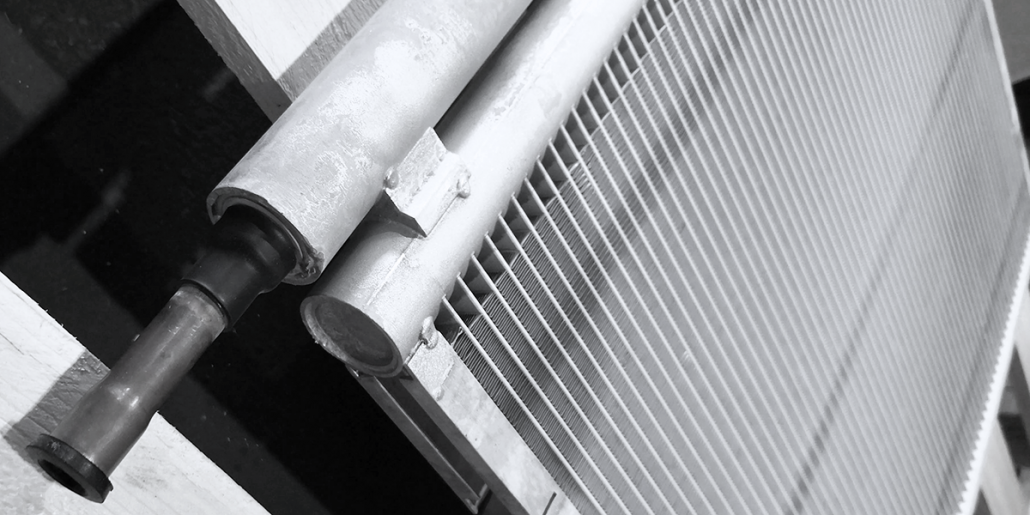Optimization of Microchannel Heat Exchangers for CO₂ Refrigerants

In line with the HVAC and refrigeration industries’ realignment to low-global-warming-potential (GWP) refrigerants, carbon dioxide (CO₂) is increasingly emerging as a viable candidate to substitute traditional hydrofluorocarbons (HFCs). As it offers low environmental impact and better thermodynamic performance, CO₂ should be processed under high pressure with heat exchanger configurations that can withstand harsh conditions without compromised efficiency and reliability. Microchannel heat exchangers are proving to be a suitable fit for this application—offering enhanced thermal performance, reduced size, and compatibility with the unique demands of transcritical and subcritical CO₂ cycles.
Application of CO₂ as a refrigerant brings with it one of its biggest challenges: its high operating pressure, especially when utilized in gas cooler applications where it exists in a supercritical state. Traditional copper-aluminum coils will fail in these conditions because they are restricted in flow distribution and mechanical strength. Microchannel heat exchangers are better capable of handling high-pressure conditions. Even refrigerant distribution through its flat aluminum tubing with several inner passages, along with increased structural strength, makes it a necessary option when working with CO₂ systems which operate as much above 1000 psi.
One advantage is reduced refrigerant charge required for microchannel coils. Because CO₂ systems inherently have greater mass flow rates required for equivalent cooling capacity, reducing the volume of refrigerant decreases system complexity and improves safety. Microchannel tube internal geometry maximizes heat transfer performance without raising charge above conventional designs—a factor for compliance with evolving safety and environmental codes.
Thermal Efficiency and Optimum Flow in CO₂ Systems
Proper refrigerant flow management is a crucial component in the optimization of CO₂ microchannel heat exchangers. Unlike HFCs that operate on subcritical cycles with clear phase changes, CO₂ involves a supercritical state in a majority of commercial heat pump and refrigeration systems. This means that the traditional temperature glide assumptions do not apply and surfaces on heat exchanger coils need to be designed to cope with varying fluid properties along the coil.
To address this, channel geometry and headers have been maximized for balanced flow distribution by producers. Computational fluid dynamics (CFD) modeling is used to maximize such designs before they go into production. The result is a microchannel coil with stable heat rejection rates even at varying pressure and temperature gradients—providing reliable system performance for cooling and heating operations.
In addition to thermal improvements, advances in surface finishes have also provided for increased durability of microchannel heat exchangers used in CO₂ refrigerant applications. Protection against corrosion due to moisture exposure is provided through application of protective coatings, especially where humidity variation is present in the ambient environment. Such properties are well suited to microchannel coils in supermarket refrigeration, cold storage warehouses, and heat pump applications where CO₂ is gaining popularity.
For retrofitting engineers working with previously existing equipment originally built around Trane components, utilizing new microchannel replacement coils optimized for CO₂ use offers a viable alternative. Many legacy Trane units were built with R-404A or R-410A refrigerants and may not perform at peak efficiency under the higher pressures of CO₂. Utilization of microchannel versions in retrofitting offers an adaptation into newer refrigerant designs with or even higher thermal output.
Experts looking to obtain tested, high-performance replacements engineered to suit Trane-based CO₂ systems can find comprehensive product information and technical support at https://www.kaltra.com/microchannel-replacement-coils/trane-coils. There, they will find solutions that meet the evolving needs of modern refrigeration technology while meeting long-term sustainability goals.
Durability and Long-Term Performance Considerations
Aside from thermal efficiency, mechanical longevity of microchannel heat exchangers is also highly critical for CO₂ application. High-pressure operation imposes additional stress on tube walls and brazed joints, and therefore structural integrity is a top priority. Higher-order processes such as controlled atmosphere brazing and laser welding yield robust, leak-free seals that remain for the lifetime of the application—despite continuous cycling and elevated pressures.
Additionally, the light weight of microchannel coils facilitates easier installation and places less mechanical stress on support frameworks. In rooftop configurations, industrial chillers, and packaged refrigeration units, this translates into less maintenance and longer life—a key benefit for buildings that need to minimize downtime and repair costs.
The shift to CO₂ refrigeration is not a matter of environmental need—it’s a technology push that requires careful selection of components. Through the use of microchannel heat exchangers specifically designed for CO₂ use, plant managers and engineers are positioning their systems for long-term success in an age of diminishing emissions mandates and escalating energy costs.
No matter its application in a new construction or as an upgrade to an existing installation, heat exchanger optimization for CO₂ refrigerants is a wise investment in more efficient, more sustainable thermal management. As an industry all but irreversibly on the course of going green, microchannel technology is the proven solution—though one that does so without any compromise of efficiency or reliability.

.jpeg?width=682&height=455&name=AdobeStock_295048993%20(1).jpeg)



